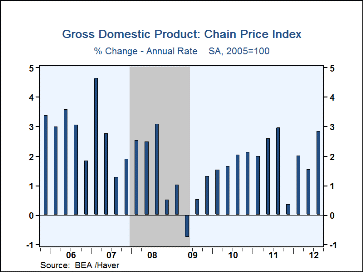 Global| Oct 26 2012
Global| Oct 26 2012U.S. GDP Growth Firms But Price Inflation Accelerates
by:Tom Moeller
|in:Economy in Brief
Summary
Economic growth recovered somewhat last quarter. Real GDP increased at a 2.0% (2.3% y/y) annual rate, up from the unrevised 1.3% Q2 gain. Consensus expectations were for a 1.8% rise. Improved growth in domestic final sales drove the [...]
Economic growth recovered somewhat last quarter. Real GDP increased at a 2.0% (2.3% y/y) annual rate, up from the unrevised 1.3% Q2 gain. Consensus expectations were for a 1.8% rise. Improved growth in domestic final sales drove the gain with a 2.3% (2.0% y/y) advance. Growth in GDP and domestic sales were, however, only back to the Q1 rate.
Improved gains in domestic sales were broad-based. Personal consumption expenditure growth rose to 2.0% (2.0% y/y) as spending on motor vehicles increased at a 7.3% (8.9% y/y) rate and home furnishings & appliances outlays rose at an 8.2% (6.4% y/y) rate. Spending on clothing also posted a strong 6.2% (2.5% y/y) increase but services outlays rose just 0.8% (1.1% y/y). Government purchases rose at a 3.7% rate (-0.6% y/y). That increase was the first in over two years and was powered by a 13.1% (-1.6% y/y) rise in defense outlays. Residential investment also rose a strong 14.4% (13.8% y/y). To the downside, fixed business investment was a drag on growth and fell at a 1.3% rate (+4.7% y/y), the first quarterly decline in nearly three years.
The foreign trade sector had little effect on GDP growth. The 0.2 percentage point subtraction reflected a 1.6% (+2.3% y/y) decline in exports and a 0.2% (+2.6% y/y) slip in imports. Inventories subtracted a minimal 0.1 percentage point from growth. Farm inventories alone, however, reduced GDP growth by 0.4 percentage points due to the drought.
The GDP chain price index rose at an elevated 2.8% (1.7% y/y) rate, bolstered by a 6.6% (-1.3% y/y) decline in the import price index. The gain in the domestic final sales price index remained moderate at a 1.6% (1.4% y/y) rate.
The latest GDP figures can be found in Haver's USECON and USNA databases; USNA contains basically all of the Bureau of Economic Analysis' detail on the national accounts, including the new integrated economics accounts and the recently added GDP data for U.S. Territories. The Consensus estimates can be found in AS1REPNA.
| Chained 2005 $,% AR | Q3'12 (Advance) | Q2'12 | Q1'12 | Q3'12 Y/Y |
2011 | 2010 | 2009 |
|---|---|---|---|---|---|---|---|
| Gross Domestic Product | 2.0 | 1.3 | 2.0 | 2.3 | 1.8 | 2.4 | -3.1 |
| Inventory Effect | -0.1 | -0.5 | -0.4 | 0.4 | -0.2 | 1.5 | -0.8 |
| Final Sales | 2.1 | 1.7 | 2.4 | 1.9 | 2.0 | 0.9 | -2.3 |
| Foreign Trade Effect | -0.2 | 0.2 | 0.2 | 0.1 | 0.2 | -0.4 | 1.0 |
| Domestic Final Sales | 2.3 | 1.4 | 2.2 | 2.0 | 1.8 | 1.3 | -3.3 |
| Demand Components | |||||||
| Personal Consumption | 2.0 | 1.5 | 2.4 | 2.0 | 2.5 | 1.8 | -1.9 |
| Business Fixed Investment | -1.3 | 3.6 | 7.5 | 4.7 | 8.6 | 0.7 | -18.1 |
| Residential Investment | 14.4 | 8.4 | 20.6 | 13.8 | -1.4 | -3.1 | -22.4 |
| Government Spending | 3.7 | -0.7 | -3.0 | -0.6 | -3.1 | 0.6 | 3.7 |
| Chain-Type Price Index | |||||||
| GDP | 2.8 | 1.6 | 2.0 | 1.7 | 2.1 | 1.3 | 0.9 |
| Final Sales of Domestic Product | 2.9 | 1.5 | 2.0 | 1.7 | 2.1 | 1.3 | 0.9 |
| Final Sales to Domestic Purchasers | 1.6 | 0.7 | 2.5 | 1.4 | 2.5 | 1.6 | -0.2 |
Tom Moeller
AuthorMore in Author Profile »Prior to joining Haver Analytics in 2000, Mr. Moeller worked as the Economist at Chancellor Capital Management from 1985 to 1999. There, he developed comprehensive economic forecasts and interpreted economic data for equity and fixed income portfolio managers. Also at Chancellor, Mr. Moeller worked as an equity analyst and was responsible for researching and rating companies in the economically sensitive automobile and housing industries for investment in Chancellor’s equity portfolio. Prior to joining Chancellor, Mr. Moeller was an Economist at Citibank from 1979 to 1984. He also analyzed pricing behavior in the metals industry for the Council on Wage and Price Stability in Washington, D.C. In 1999, Mr. Moeller received the award for most accurate forecast from the Forecasters' Club of New York. From 1990 to 1992 he was President of the New York Association for Business Economists. Mr. Moeller earned an M.B.A. in Finance from Fordham University, where he graduated in 1987. He holds a Bachelor of Arts in Economics from George Washington University.










